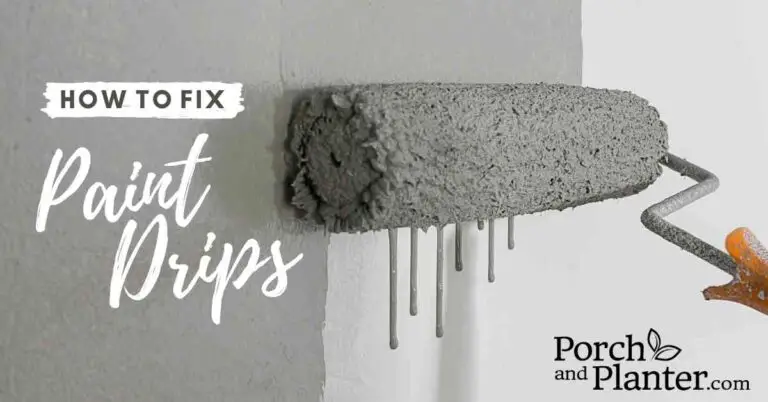Skim Coat Questions Answered! Everything You Need to Know

Skim coating is a great way to prepare your walls for painting, but it’s not always easy for those who’ve never done it before. People debate the best techniques and practices for skim coating so it can be difficult to know if you’ve prepared for your new project properly. We’ve compiled all the most common questions people have about skim coating in this article, so you can prep for skim coating with confidence!
Also, be sure to check out our article on How to Skim Coat if you haven’t already! We layout a step-by-step process for skim coating like a pro.
What Is a Skim Coat?
A skim coat is a thin layer of watered-down joint compound (also commonly referred to as “mud”) that is applied over drywall to create a smooth, even finish in preparation for painting. It can be applied with a trowel or knife and is then usually sanded for a smooth finish after two to three coats. A skim coat is also often used to even out and repair walls after damage or wallpaper removal.
What Is Skim Coat Made Of?
Skim coat is made of diluted joint compound. Joint compound either comes pre-mixed or as a powder you add water to and mix yourself. To turn joint compound into skim coat, you just need to mix in additional water to make it thinner.
How Much Water Should I Add to Joint Compound to Make Skim Coat?
You should add enough water to give your skim coat a yogurt-like consistency. The exact amount of water you add will depend on the brand of joint compound you are using and whether it is pre-mixed or powder. Add water a little at a time, as you can always add more water if you need to.
Is Skim Coat the Same as Joint Compound?
Yes, skim coat is the same as joint compound, because it is just joint compound with more water added to create a thinner mixture. This allows it to layer more freely on the surface of the drywall, which is why it’s referred to as a skim coat.
Why Should You Skim Coat?
Skim coating is a very important step for preparing your walls or ceiling for painting. It creates a smooth surface that will give you an even finish when you paint on top of it. Skim coating can be used to fix drywall damage, create a crisp edge between two pieces of drywall, and level the wall after wallpaper removal.
It’s also a great way to ensure a nice, even wall surface on older walls. Walls sustain minor damage like dents, scratches, nail holes, and cracks over time, so skim coating them creates a new surface so they’ll look brand new when you apply paint.
How Is Skim Coating Different Than Other Types of Wall Finishing?
Skim coating is done before any other type of wall surface finish, whether it is drywall, paneling or wood. It is used to create a smooth surface for the final type of wall finish to be applied. Because skim coating is done using joint compound, which will stick to almost anything, it also works to fill holes and minor cracks in the wall before any other type of finish goes on top of it.
When Is Skim Coating Necessary?
Skim coating is necessary in several different cases. If you’re putting in fresh drywall, patching older drywall, flattening out texture, or filling cracks, dents, or holes throughout the wall surface, skim coating the wall is a necessary step to ensure a good surface finish when you paint them.
If your walls are still in good repair and you’re just looking to repaint, you probably don’t need to skim coat them.
Should You Use Primer Before Skim Coating?
You don’t need to prime before skim coating if the surface is fresh drywall. The skim coat will stick to the drywall without issues. If you’re skim coating over old paint, however, you’re best off priming before you skim coat. The primer will ensure that the skim coat will stick because the skim coat has a hard time adhering to gloss or semigloss paint.
What Primer Should You Use Before Skim Coating?
You should use a water-based, stain-blocking sealer and primer before skim coating. Water-based primer is better for your family and the environment than oil-based primers, which can contain VOCs.
Can You Sand Skim Coat?
Yes, you can sand skim coat when it is dry. This will allow you to smooth out the surface and make it even.
When Should You Sand Skim Coat?
You should sand skim coat after your final layer of skim coat dries. In between coats, you can scrape off any defects with a 6-inch knife instead of sanding between coats, which creates a lot of dust.
Should You Skim Coat New Drywall?
Yes, you should skim coat new drywall. This will ensure that the surface is smooth and even before painting and cover-up any defects in the drywall. Skim coating can also help to solve problems such as studs that were not plumb and drywall tape seams that don’t meet up.
Can You Skim Coat Over Paint?
Yes, you can skim coat over paint if you use a primer beforehand. This will ensure that the skim coat sticks well to the wall.
Can You Skim Coat Over Wallpaper?
It’s not recommended that you skim coat directly over wallpaper. Instead, you should first remove the wallpaper and prime the wall before you apply your skim coat. This will ensure that the skim coat adheres to the wall properly.
Can You Skim Coat Over Wallpaper Glue?
You should not skim coat directly over wallpaper glue. This can lead to potential issues with skim coat adhesion. You should seal the wallpaper glue by using a primer over the wall you plan on skim coating, and then skim coating over the primer.
Can You Skim Coat Over a Popcorn Ceiling?
Yes, you can skim coat over a popcorn ceiling. Skim coating over a popcorn ceiling is one of the easiest ways to level out a popcorn ceiling to give it a fresh, modern look. Popcorn ceilings can hold a lot of dust, so it’s important to make sure that your ceiling is clean before skim coating to ensure proper adhesion.
*If your house was built before the 1990’s, you should make sure that your popcorn ceiling doesn’t contain asbestos by using a home test kit or calling in a specialist. If your ceiling does contain asbestos, you should not do anything to it yourself. Asbestos is dangerous and is best handled by asbestos removal professionals.
Can You Skim Coat Over Plaster?
Yes, you can skim coat over plaster. Skim coating over plaster walls is one of the best ways to remove the hairline cracks that plaster walls are prone to. Adding a coat or two of skim coat to plaster can reduce the unsightly cracks and restore an even surface to your walls.
Can You Skim Coat Over Painted Concrete?
Yes, you can skim coat over painted concrete if you use a good primer over it first. Primer will give the skim coat a good surface to bond to. If the concrete wall is painted with a particularly glossy paint, it’s also recommended that you scuff up the surface with a low grit sandpaper to ensure good adhesion.
Does Skim Coat Crack?
Skim coat can crack if it is not applied properly. Smaller hairline cracks are the most common with cracks in skim coat, and those can be filled with more skim coat or joint compound.
Why Does Skim Coat Crack?
Skim coat can crack for a few different reasons:
- The skim coat did not have the right moisture content when applied.
- The surface was not properly primed or was covered with dust or dirt before applying skim coat.
- The skim coat dried too quickly due to heat or a draft.
How to Fix Cracks in Skim Coat
To fix cracks in skim coat, first sand down any uneven surfaces caused by the cracks. Then, you can apply another layer of skim coat to fix the surface.
When to Use Joint Compound vs. Skim Coat
Skim coating and joint compound are both used for small surface defects, but there is a difference between the two:
Joint compound should only be applied over drywall while skim coat can be applied over drywall or plaster. Joint compound also dries much more quickly than skim coat.
Skim coat takes longer to apply, but it is easier to sand and won’t shrink as much as joint compound. It is also more efficient for covering a whole wall quickly.
You should use joint compound when you only need to touch up a few small spots on a wall from things like nail holes or a small dent or two. You should use skim coat when there is damage covering a large portion of the wall or you want to resurface or retexture the entire wall.
Should You Use a Trowel or Knife for Skim Coat?
Both a trowel and a putty knife can be used to apply a skim coat. You should use whichever one you feel most comfortable with or have more success using. Most professional contractors prefer to use a knife for applying skim coat, as the thinner metal surface of the knife is easier to flex for finer control.
How Many Coats of Skim Coat Should I Apply?
You should apply around 3 coats of skim coat when resurfacing walls, but how many coats depends on the condition of the surface underneath.
If you are resurfacing a wall that has lots of cracks or other common problems, then adding 3 coats will increase the durability of the finished surface. If there are no major issues with the existing surface, applying 2 coats should be sufficient to cover all but the closest inspections.
How Long Does Skim Coat Take to Dry?
Most people wait around 24 hours for skim coat to dry. How long it takes for a skim coat to dry depends on the thickness of the coats and how humid or damp it is in the air. It can take a little longer if you add multiple thin layers instead of one thick layer.
Does Skim Coat or Joint Compound Have a Sandable Time?
Joint compound does not have a sandable time. You should only be able to skim coat over finished joint compound an hour after it has been applied, but you should wait around 24 hours for the skim coat to cure before sanding.
Skim coating is a great way to resurface your wall affordably and with less waste than replacing the drywall, making it much better for the environment than the other alternatives. Hopefully, this article has answered some of your questions about skim coating.
Be sure to check out our guide on how to skim coat as well when you’re ready to start!



![Is It Worth It to Replace a Refrigerator Compressor? [ANSWERED]](https://porchandplanter.com/wp-content/uploads/2021/09/worth-it-to-replace-refrigerator-compressor-768x402.jpg)

